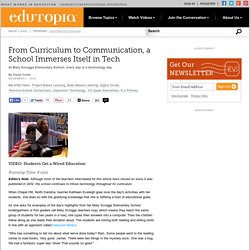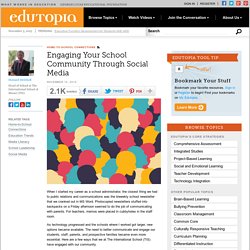

Benefits-barriers.pdf. Effects of Technology on Classrooms and Students. A r c h i v e d I n f o r m a t i o n Change inStudent andTeacherRoles When students are using technology as a tool or a support for communicating with others, they are in an active role rather than the passive role of recipient of information transmitted by a teacher, textbook, or broadcast. The student is actively making choices about how to generate, obtain, manipulate, or display information. Technology use allows many more students to be actively thinking about information, making choices, and executing skills than is typical in teacher-led lessons. Moreover, when technology is used as a tool to support students in performing authentic tasks, the students are in the position of defining their goals, making design decisions, and evaluating their progress.
The teacher's role changes as well. Project-based work (such as the City Building Project and the Student-Run Manufacturing Company) and cooperative learning approaches prompt this change in roles, whether technology is used or not. From Curriculum to Communication, a School Immerses Itself in Tech. Editor's Note: Although most of the teachers interviewed for this article have moved on since it was published in 2002, the school continues to infuse technology throughout its curriculum.

When Chapel Hill, North Carolina, teacher Kathleen Eveleigh goes over the day's activities with her students, she does so with the gratifying knowledge that she is fulfilling a host of educational goals. As she asks for examples of the day's highlights from her Mary Scroggs Elementary School kindergartners or first graders (all Mary Scroggs teachers loop, which means they teach the same group of students for two years in a row), she types their answers into a computer. Then the children follow along as she reads their dictation aloud. The students are honing both reading and writing skills in line with an approach called balanced literacy.
"Who has something to tell me about what we've done today? Engaging Your School Community Through Social Media. When I started my career as a school administrator, the closest thing we had to public relations and communications was the biweekly school newsletter that we cranked out in MS Word.

Photocopied newsletters stuffed into backpacks on a Friday afternoon seemed to do the job of communicating with parents. For teachers, memos were placed in cubbyholes in the staff room. As technology progressed and the schools where I worked got larger, new options became available. Google_This.pdf. Using Facebook and Other SNSs in K-12 Classrooms Ethical Considerations for Safe Social Networking. Rural Elementary School Teachers' Technology Integration. Assistive technology in special education and the universal design for learning. Using Nearpod in Elementary Guided Reading Groups. Technology-Enhanced Project-Based Learning: Effects on Historical Thinking.